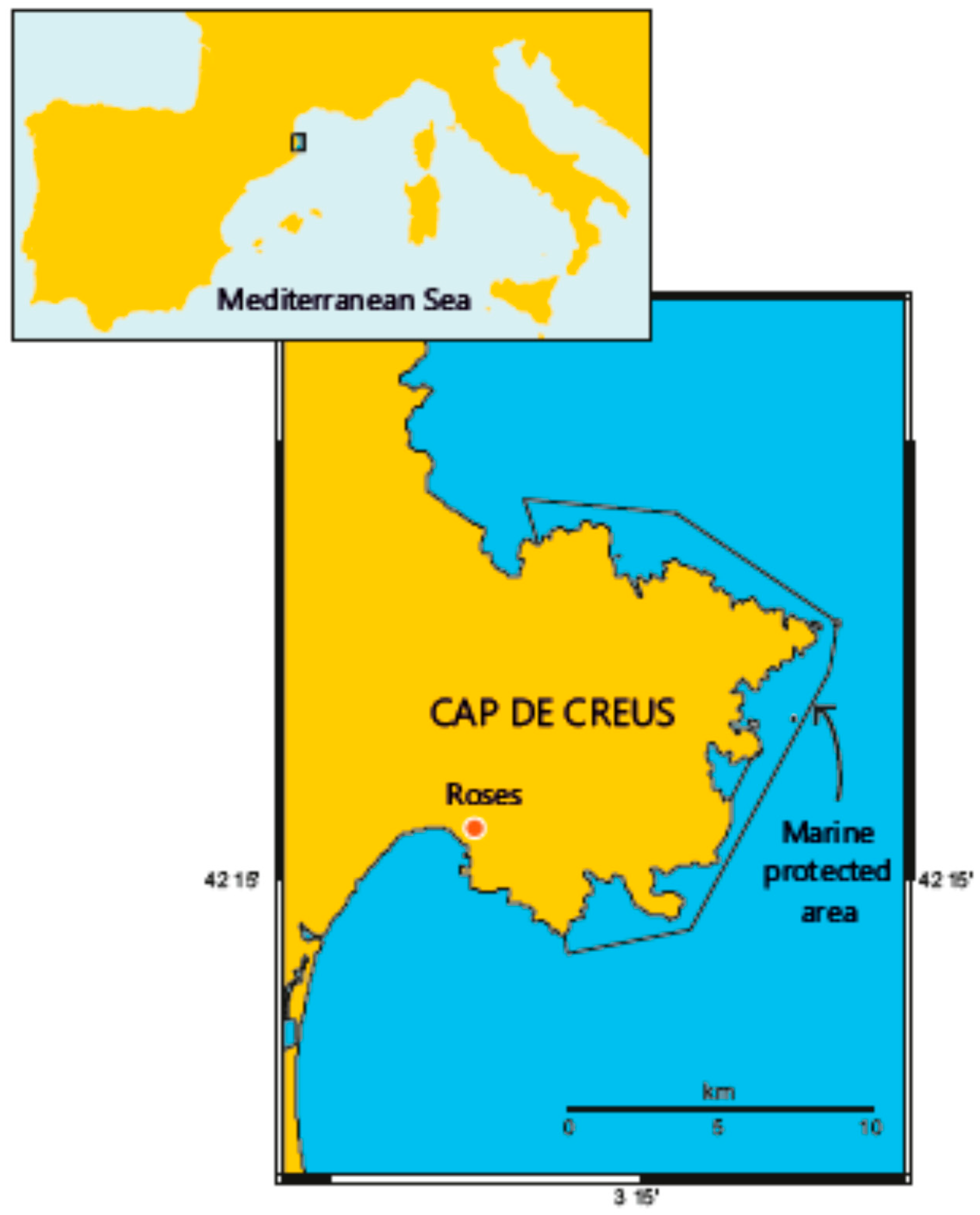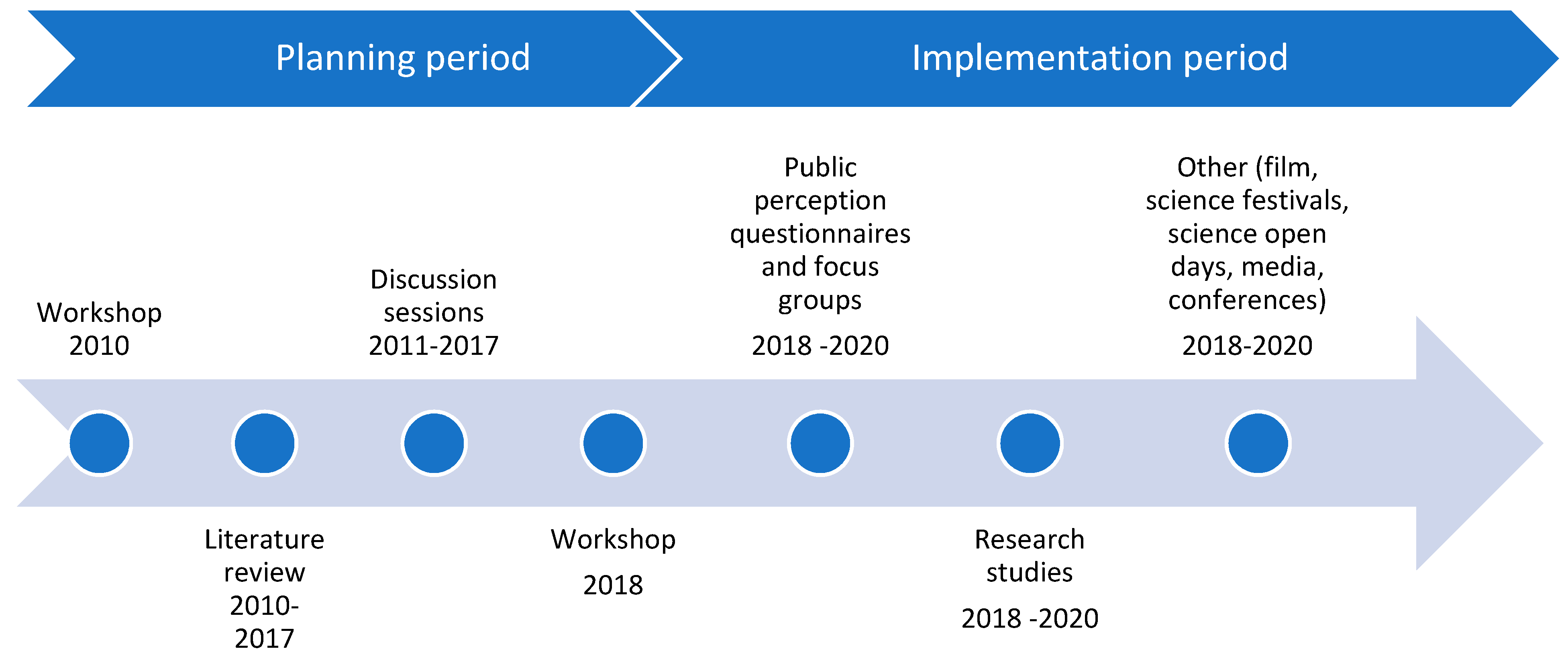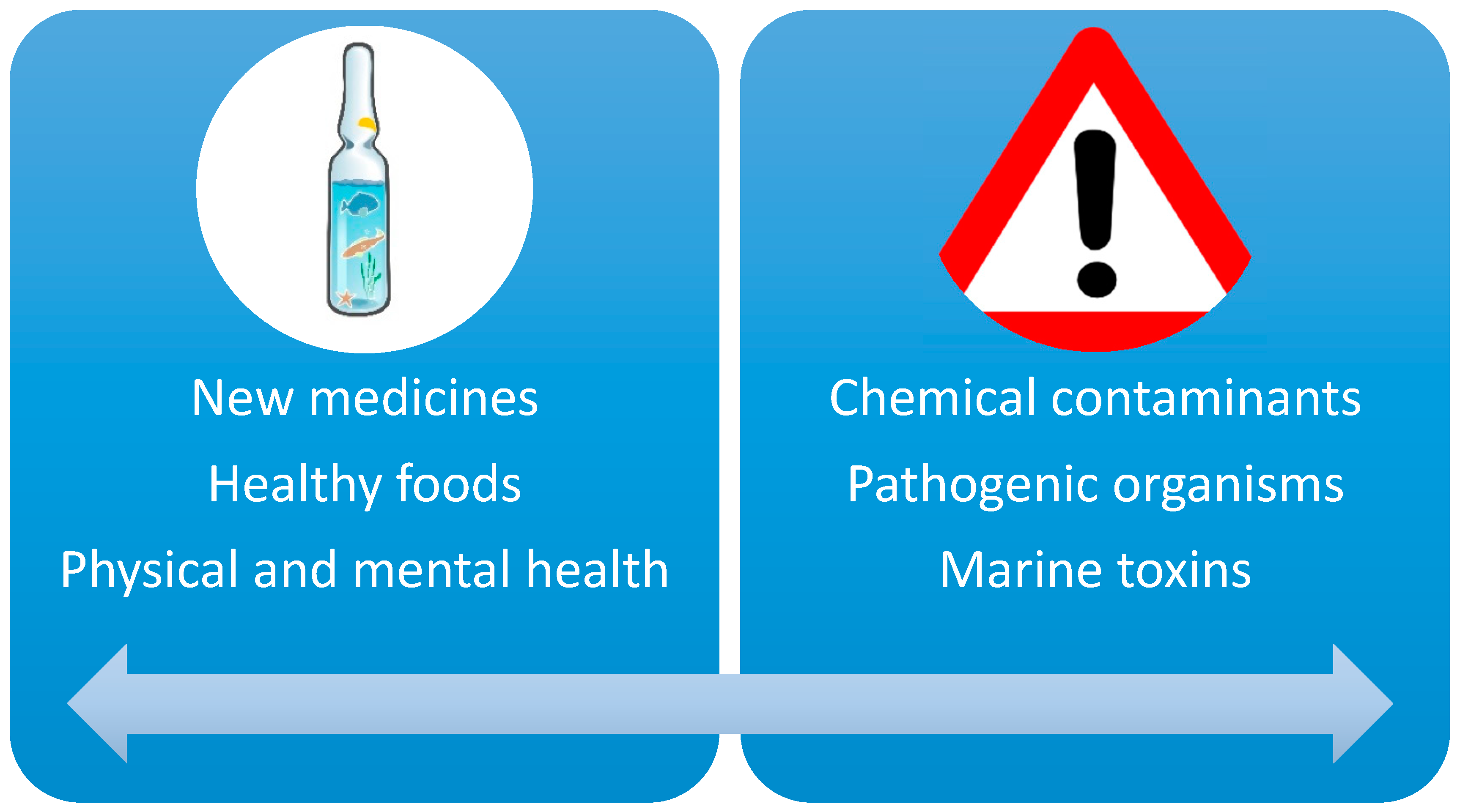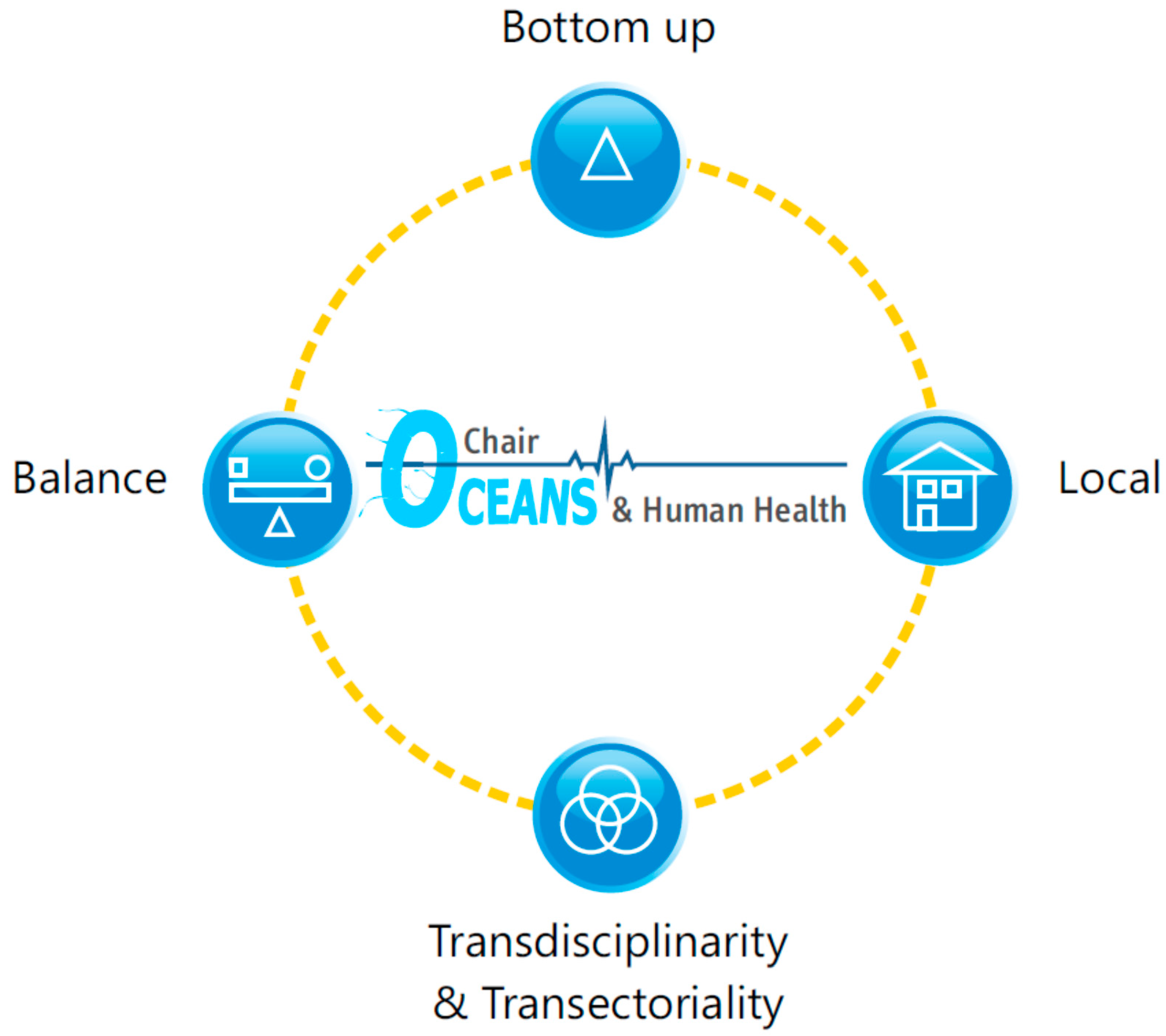The Roses Ocean and Human Health Chair: A New Way to Engage the Public in Oceans and Human Health Challenges
Abstract
:1. Introduction
2. The OHH Chair: Setting the Scene
3. The Role of the Marine Protected Area of Cap de Creus
4. Materials and Methods
5. Results
5.1. Geographical Dimensions
5.2. Current and Emerging OHH Issues
5.3. The Positive Outcomes and Lessons Derived from the Chair
- (i)
- the promotion of the marine environment for recreational use to treat or possibly decrease the prevalence of mental disorders, non-communicable diseases (NCDs) that are the leading cause of disability in many Western European countries [18], vs. the need to prevent overcrowding and the consequent environmental degradation of blue spaces, including the impact of ecotourism activities such as scuba diving in MPAs [37];
- (ii)
- the promotion of seafood consumption as a source of high-quality nutrients in the Mediterranean diet vs. the decline of fish stocks due to overfishing and climate change in the Mediterranean, the health risks posed by contaminated seafood, and changing dietary preferences [36];
- (iii)
- the exploration of marine species with bioactive potential to discover new drugs vs. the conservation of these species and overall biodiversity. Although only small quantities of biological resources are harvested, exploring the ocean for new biotechnological products can cause significant environmental disturbance with potential adverse effects [14]. Furthermore, the growing importance and value attached to alternative medicine based on animal and plant products in some countries may increase the risk of the extinction of vulnerable species.
5.4. Drawbacks and Difficulties Encountered
6. Discussion
7. Conclusions
- Bottom-up approaches can engage communities in oceans and human health challenges;
- Responses to these challenges need a trans-sectorial and transdisciplinary vision;
- Improvement in these challenges should be rooted in local circumstances;
- The Oceans and Human Health Chair shows how diverse stakeholders can co-create together towards their health and the health of their local environment.
Supplementary Materials
Author Contributions
Funding
Acknowledgments
Conflicts of Interest
References
- Hinchcliffe, S.; Jackson, M.; Wyatt, K.; Barlow, A.; Barreto, M.; Clare, L.; Depledge, M.; Durie, R.; Fleming, L.E.; Groom, N.; et al. Healthy publics: Enabling cultures and environments for health. Palgrave Commun. 2018, 4, 57. [Google Scholar] [CrossRef] [PubMed]
- Maguire, K.; Garside, R.; Poland, J.; Fleming, L.E.; Alcock, I.; Taylor, T.; Macintyre, H.; Lo Iacono, G.; Green, A.; Wheeler, B.W. Public involvement in research about environmental change and health: A case study. Health 2019, 23, 215–233. [Google Scholar] [CrossRef] [Green Version]
- Fisher, R.; Ury, W. Getting to YES: Negotiating Agreement without Giving in; Random House Business: Penguin Books Ltd.: London, UK, 1989. [Google Scholar]
- Midgley, J. Industrialization and welfare: The case of the four little tigers. Soc. Policy Adm. 1986, 20, 225–238. [Google Scholar] [CrossRef]
- Sager, F. Governance and coercion. Political Stud. 2009, 57, 537–558. [Google Scholar] [CrossRef]
- Innes, J.E.; Booher, D.E. Indicators for sustainable communities: A strategy building on complexity theory and distributed intelligence. Plan. Theory Pract. 2000, 1, 173–186. [Google Scholar] [CrossRef]
- Innes, J.E.; Booher, D.E. Planning with complexity: An introduction to collaborative rationality for public policy. In Planning with Complexity: An Introduction to Collaborative Rationality for Public Policy; Routledge Taylor & Francis Group: Abingdon, UK, 2010. [Google Scholar] [CrossRef]
- Slaev, A.D.; Kovachev, A.; Nozharova, B.; Daskalova, D.; Nikolov, P.; Petrov, P. Overcoming the failures of citizen participation: The relevance of the liberal approach in planning. Plan. Theory 2019, 18, 448–469. [Google Scholar] [CrossRef]
- Bracken, L.J.; Bulkeley, H.A.; Whitman, G. Transdisciplinary research: Understanding the stakeholder perspective. J. Environ. Plan. Manag. 2015, 58, 1291–1308. [Google Scholar] [CrossRef] [Green Version]
- Thompson, M.A.; Owen, S.; Lindsay, J.M.; Leonard, G.S.; Cronin, S.J. Scientist and stakeholder perspectives of transdisciplinary research: Early attitudes, expectations, and tensions. Environ. Sci. Policy 2017, 74, 30–39. [Google Scholar] [CrossRef]
- Mach, K.J.; Lemos, M.C.; Meadow, A.M.; Wyborn, C.; Klenk, N.; Arnott, J.C.; Ardoin, N.M.; Fieseler, C.; Moss, R.H.; Nichols, L.; et al. Actionable knowledge and the art of engagement. Curr. Opin. Environ. Sustain. Elsevier. BV 2020. [Google Scholar] [CrossRef]
- Mielke, J.; Vermaßen, H.; Ellenbeck, S. Ideals, practices, and future prospects of stakeholder involvement in sustainability science. Proc. Natl. Acad. Sci. USA 2017, 114, 10648–10657. [Google Scholar] [CrossRef] [Green Version]
- Thompson, B.S.; Bladon, A.J.; Fahad, Z.H.; Mohsanin, S.; Koldewey, H.J. Evaluation of the ecological effectiveness and social appropriateness of fishing regulations in the Bangladesh Sundarbans using a new multi-disciplinary assessment framework. Fish. Res. 2016, 183, 410–423. [Google Scholar] [CrossRef]
- H2020 SOPHIE Consortium. A Strategic Research Agenda for Oceans and Human Health in Europe; H2020 SOPHIE Project: Ostend, Belgium, 2020; ISBN 9789492043894. [Google Scholar] [CrossRef]
- Novoa, A.; Shackleton, R.; Canavan, S.; Cybèle, C.; Davies, S.J.; Dehnen-Schmutz, K.; Fried, J.; Gaertner, M.; Geerts, S.; Griffiths, C.L.; et al. A framework for engaging stakeholders on the management of alien species. J. Environ. Manage. 2018, 205, 286–297. [Google Scholar] [CrossRef] [PubMed] [Green Version]
- Leppo, K.; Ollila, E.; Peña, S.; Wismar, M.; Cook, S. Health in all policies. In Seizing Opportunities, Implementing Policies; Ministry of Social Affairs and Health: Helsinki, Finland, 2013; p. 358. [Google Scholar]
- Pruüss-Ustün, A.; Corvalán, C.F.; WHO. Preventing Disease through Healthy Environments: Towards an Estimate of the Environmental Burden of Disease; World Health Organization: Geneva, Switzerland, 2006. [Google Scholar]
- WHO. World Health Statistics 2019: Monitoring health for the SDGs. In Licence: CC BY-NC-SA 3.0 IGO; World Health Organization: Geneva, Switzerland, 2019; p. 132. Available online: https://www.who.int/gho/publications/world_health_statistics/2019/en/ (accessed on 25 May 2020).
- Gascon, M.; Zijlema, W.; Vert, C.; White, M.P.; Nieuwenhuijsen, M.J. Outdoor blue spaces, human health and wellbeing: A systematic review of quantitative studies. Int. J. Hyg. Environ. Health 2017, 220, 1207–1221. [Google Scholar] [CrossRef] [PubMed]
- White, M.P.; Alcock, I.; Grellier, J.; Wheeler, B.W.; Hartig, T.; Warber, S.L.; Bone, A.; Depledge, M.H.; Fleming, L.E. Spending at least 120 minutes a week in nature is associated with good health and wellbeing. Sci. Rep. 2019, 9, 1–11. [Google Scholar] [CrossRef] [Green Version]
- Elliott, L.R.; White, M.P.; Grellier, J.; Garrett, J.K.; Cirach, M.; Wheeler, B.W.; Bratman, G.N.; van den Bosch, M.A.; Ojala, A.; Roiko, A.; et al. Residential distance and recreational visits to coastal and inland blue spaces in eighteen countries. Landsc. Urban Plan. 2020, 198. [Google Scholar] [CrossRef]
- Robinson, J.M.; Breed, M.F. Green Prescriptions and their co-benefits: Integrative strategies for public and environmental health. Chall. MDPI Open Access J. 2019, 10, 9. [Google Scholar] [CrossRef] [Green Version]
- Weible, C.; Sabatier, P.A.; Lubell, M. A Comparison of a collaborative and top-down approach to the use of science in policy: Establishing marine protected areas in california. Policy Stud. J. 2004, 32, 187–207. [Google Scholar] [CrossRef]
- Jentoft, S.; McCay, B.J.; Wilson, D.C. Social theory and fisheries co-management. Mar. Policy 1998, 22, 423–436. [Google Scholar] [CrossRef]
- I&DEA. A Glass Half-Full: How an Asset Approach can Improve Community Health and wellbeing Improvement and Development Agency (IDeA); Healthy Communities: London, UK, 2010; p. 32. [Google Scholar]
- Bunt, L.; Harris, M. (Eds.) Mass Localism. Discussion Paper; NESTA: London, UK, 2010; p. 52. [Google Scholar]
- Durie, R.; Wyatt, K. Connecting communities and complexity: A case study in creating the conditions for transformational change. Crit. Public Health 2013, 23, 174–187. [Google Scholar] [CrossRef]
- Coalition for Collaborative Care. Leadership for Empowered and Healthy Communities Programme. 2020. Available online: http://coalitionforcollaborativecare.org.uk/lecpc/ (accessed on 15 May 2020).
- The Scottish Government. Good Places, Better Health is about Responding to the Challenges We Face in Creating Safe and Positive Environments which Nurture Better and more Equal Health and Wellbeing; the Scottish Government: Edinburgh, Scotland, UK, 2008; p. 26.
- Fleming, L.E.; Maycock, B.; White, M.P.; Depledge, M.H. Fostering human health through ocean sustainability in the 21st century. People Nat. 2019, 1, 276–283. [Google Scholar] [CrossRef] [Green Version]
- Erdner, D.L.; Dyble, J.; Parsons, M.L.; Stevens, R.C.; Hubbard, K.A.; Wrabel, M.L.; Moore, S.K.; Lefebvre, K.A.; Anderson, D.M.; Bienfang, P.; et al. Centers for Oceans and Human Health: A unified approach to the challenge of harmful algal blooms. Environ. Health 2008, (Suppl. S2). [Google Scholar] [CrossRef] [PubMed] [Green Version]
- Vila, M.; Abós-Herràndiz, R.; Isern-Fontanet, J.; Àlvarez, J.; Berdalet, E. Establishing the link between Ostreopsis cf. ovata blooms and human health impacts using ecology and epidemiology. Sci. Mar. 2016, 80 (Suppl. S1), 107–115. [Google Scholar] [CrossRef] [Green Version]
- INVOLVE. What Is Public Involvement in Research? NIHR. 2018. Available online: http://www.invo.org.uk/find-out-more/what-is-public-involvement-in-research-2/ (accessed on 7 January 2020).
- Depledge, M.H.; Harvey, A.J.; Brownlee, C.; Frost, M.; Moore, M.N.; Fleming, L.E. Changing views of the interconnections between the oceans and human health in Europe. Microb. Ecol. Springer 2013. [Google Scholar] [CrossRef]
- Borja, A.; White, M.P.; Berdalet, E.; Bock, N.; Eatock, C.; Kristensen, P.; Leonard, A.; Lloret, J.; Pahl, S.; Parga, M.; et al. Moving toward an agenda on ocean health and human health in Europe. Front. Mar. Sci. 2020, 7, 37. [Google Scholar] [CrossRef] [Green Version]
- Lloret, J.; Rätz, H.J.; Lleonart, J.; Demestre, M. Challenging the links between seafood and human health in the context of global change. J. Mar. Biolog. Assoc. UK 2016, 96, 29–42. [Google Scholar] [CrossRef]
- Lloret, J.; Riera, V. Evolution of a Mediterranean coastal zone: Human impacts on the marine environment of Cape Creus. Environ. Manage. 2008, 42, 977–988. [Google Scholar] [CrossRef]
- Font, T.; Lloret, J. Biological implications of recreational shore angling and harvest in a marine reserve: The case of Cape Creus. Aquat. Conserv. Mar. Freshw. Ecosyst. 2011, 21, 210–217. [Google Scholar] [CrossRef]
- Lloret, J.; Zaragoza, N.; Caballero, D.; Riera, V. Impacts of recreational boating on the marine environment of Cap de Creus (Mediterranean Sea). Ocean Coast. Manag. 2008, 51, 749–754. [Google Scholar] [CrossRef]
- Olsson, P.; Folke, C. Local ecological knowledge and institutional dynamics for ecosystem management: A study of Lake Racken watershed, Sweden. Ecosystems 2001, 4, 85–104. [Google Scholar] [CrossRef]
- Jürges, H.; Avendano, M.; MacKenbach, J.P. Are different measures of self-rated health comparable? An assessment in five European countries. Eur. J. Epidemiol. 2008, 23, 773–781. [Google Scholar] [CrossRef] [Green Version]
- Baum, F.; MacDougall, C.; Smith, D. Participatory action research. J. Epidemiol. Community Health 2006, 60, 854–857. [Google Scholar] [CrossRef] [PubMed] [Green Version]
- Irvin, R.A.; Stansbury, J. Citizen participation in decision-making: Is it worth the effort? Public Adm. Rev. 2004, 64, 55–65. [Google Scholar] [CrossRef]
- UdG. International Summer School Marine Biodiversity and Human Health ISSE 2010. 2010. Available online: http://diobma.udg.edu/handle/10256.1/1739?_ga=2.144840884.1491117563.1589537722-1690219284.1589537722 (accessed on 25 May 2020).
- UdG. International Summer School Oceans and Human Health ISSE 2018. 2018. Available online: http://www.oceanshealth.udg.edu/ca/noticies/1026-isse-2018-summer-course-i-jornada-de-divulgac.html?_ga=2.119225865.1491117563.1589537722-1690219284.1589537722 (accessed on 25 May 2020).
- McMeel, O.; Tonné, N. and Calewaert, J.B. Human Health and EU Maritime Policy: Closing the Loop; H2020 SOPHIE Project: SOPHI, Brussels, Belgium, 2019. [Google Scholar] [CrossRef]
- Dahlgren, G.; Whitehead, M. Policies and strategies to promote social equity in health. In Background Document to WHO—Strategy Paper for Europe; Institute: Stockholm, Swedish, 1991. [Google Scholar]
- Corbie-Smith, G.; Wynn, M.; Richmond, A.; Rennie, S.; Green, M.; Hoover, S.M.; Watson-Hopper, S.; Nisbeth, K.S. Stakeholder-driven, consensus development methods to design an ethical framework and guidelines for engaged research. PLoS ONE 2018, 13, e0199451. [Google Scholar] [CrossRef] [Green Version]
- Brandt, P.; Ernst, A.; Gralla, F.; Luederitz, C.; Lang, D.J.; Newig, J.; Reinert, F.; Abson, D.J.; von Wehrden, H. A review of transdisciplinary research in sustainability science. Ecol. Econ. 2013, 92, 1–15. [Google Scholar] [CrossRef]
- Kirchhoff, C.J.; Lemos, M.C.; Dessai, S. Actionable knowledge for environmental decision-making: Broadening the usability of climate science. Annu. Rev. Environ. Resour. 2013, 38, 393–414. [Google Scholar] [CrossRef]
- Agnihotri, N.T.; Greenberger, P.A. Unproved and controversial methods and theories in allergy/immunology. Allergy Asthma Proc. 2019, 40, 4904–4993. [Google Scholar] [CrossRef] [PubMed]
- Autio, P.; Komulainen, P.; Larni, H.M. Heliotherapy in atopic dermatitis: A prospective study on climatotherapy using the SCORAD index. Acta Derm. Venereol. 2002, 82, 436–440. [Google Scholar] [CrossRef] [Green Version]
- Zura, S.; Nani, M.; Majid, F.A.A.; Jaafar, A.B.; Mahdzir, A.; Musa, M.N. Potential Health Benefits of Deep Sea Water: A Review. Evid. Based Complement Alternat. Med. 2016, 6, 1–18. [Google Scholar] [CrossRef]
- Chakraborty, R.; Khan, K.M.; Dibaba, D.T.; Khan, M.A.; Ahmed, A.; Islam, M.Z. Health implications of drinking water salinity in coastal areas of Bangladesh. Int. J. Environ. Res. Public Health 2019, 16, 3746. [Google Scholar] [CrossRef] [Green Version]
- Westerdahl, J.; Ingvar, C.; Måsbäck, A.; Olsson, H. Risk of cutaneous malignant melanoma in relation to use of sunbeds: Further evidence for UV-A carcinogenicity. Br. J. Cancer 2000, 82, 1593–1599. [Google Scholar] [CrossRef] [Green Version]
- Ostrom, E. Governing the Commons: The Evolution of Institutions for Collective Action; Cambridge University Press: Cambridge, UK, 1990. [Google Scholar] [CrossRef]
- Murray, F. When Co-management Fails: A Review of Theory and Lessons Learned from Reservoir Fisheries in the Dry-Zone of Sri Lanka; Dickson, M., Brooks, A., Eds.; The WorldFish Center—Bangladesh Office: Dhaka, Bangladesh, 2007. [Google Scholar]
- Lerner, H.; Berg, C. A comparison of three holistic approaches to health: One health, EcoHealth, and Planetary Health. Front. Vet. Sci. 2017, 4, 163. [Google Scholar] [CrossRef] [PubMed]
- Hill-Cawthorne, G.A. One Health/EcoHealth/Planetary Health and their evolution. In One Planet, One Health; Sydney University Press: Sidney, Australia, 2019; pp. 1–20. [Google Scholar] [CrossRef]





| Principle | Description |
|---|---|
| Bottom-up approach | Instead of assuming that the best solutions need to be determined, prescribed, driven, or “authorised” in some way from the top, policy makers should create more opportunities for communities to develop and deliver their own solutions. |
| Think local | The need to think local to create the conditions for change to happen on a global or national scale. Governments should look for solutions beyond established large international or national organizations and consider local organizations, including primary care centers, NGOs, patients’ organizations, and citizens themselves, working hand in hand with experts. |
| Transdisciplinary and trans-sectorial approach | Cross-cutting actions among experts from several institutions (universities, research centers, local and regional governments, NGOs) and the community (patients’ organizations, fishers, the tourism industry, etc.) can be effective and efficient tools to detect needs and can be adopted as a way to study complex problems in the field of OHH. |
| Balance the many voices | The need to balance these voices among different stakeholders. The Chair approach stresses the importance of considering citizen preferences and perceptions, facilitating dialogue between citizens and experts, and reaching consensus regarding controversial environmental and health issues to bring about positive health and environmental change. This balance takes trust and dedicated time. |
© 2020 by the authors. Licensee MDPI, Basel, Switzerland. This article is an open access article distributed under the terms and conditions of the Creative Commons Attribution (CC BY) license (http://creativecommons.org/licenses/by/4.0/).
Share and Cite
Lloret, J.; Abós-Herràndiz, R.; Alemany, S.; Allué, R.; Bartra, J.; Basagaña, M.; Berdalet, E.; Campàs, M.; Carreño, A.; Demestre, M.; et al. The Roses Ocean and Human Health Chair: A New Way to Engage the Public in Oceans and Human Health Challenges. Int. J. Environ. Res. Public Health 2020, 17, 5078. https://doi.org/10.3390/ijerph17145078
Lloret J, Abós-Herràndiz R, Alemany S, Allué R, Bartra J, Basagaña M, Berdalet E, Campàs M, Carreño A, Demestre M, et al. The Roses Ocean and Human Health Chair: A New Way to Engage the Public in Oceans and Human Health Challenges. International Journal of Environmental Research and Public Health. 2020; 17(14):5078. https://doi.org/10.3390/ijerph17145078
Chicago/Turabian StyleLloret, Josep, Rafael Abós-Herràndiz, Sílvia Alemany, Rosario Allué, Joan Bartra, Maria Basagaña, Elisa Berdalet, Mònica Campàs, Arnau Carreño, Montserrat Demestre, and et al. 2020. "The Roses Ocean and Human Health Chair: A New Way to Engage the Public in Oceans and Human Health Challenges" International Journal of Environmental Research and Public Health 17, no. 14: 5078. https://doi.org/10.3390/ijerph17145078







